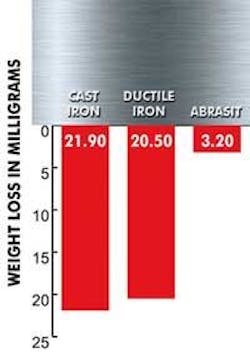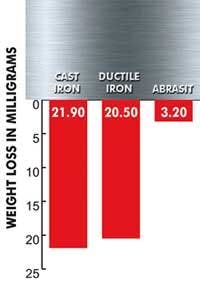Super-Hard Material, Key to Improved Pump Life in Gritty Applications
Pumps used in the movement of grit-filled wastewater typically fail early and often. This is of particular concern as grit densities are dramatically increasing. The increase is due, in part, to runoff from large surfaced-areas — which are becoming more and more prevalent in urban and suburban areas — and infiltration from ageing wastewater collection systems, along system cracks, joints, and breaks.
To combat these conditions, grit chambers are typically placed just after a plants' bar racks, but squarely ahead of all treatment activities (i.e., primary sedimentation tanks, etc.). Pumps are required in these areas to move the wastewater forward in the process, and — until recently — the pumps subjected to duty in these harsh, grit-filled areas were known primarily for their minimum life and maximum maintenance requirements. (Typically, pumps employ cast iron for casting and impeller components, which is highly vulnerable to grit-filled liquid.)
The abrasive character of grit makes it a particularly significant concern relative to the reliability and operating expense of these wastewater pumping systems. Even small increases in abrasive grit content can have devastating affects on pump casing and impeller life. Grit-filled wastewater has the very real effect of abrasively altering pump and impeller surface geometries — degrading the hydraulic capabilities of pumping units. Often, the erosive effect reaches a point where the danger of clogging rises to unacceptable levels.
Approaches that place pumps outside of the grit chamber have been tried, but generally, have not proven to be cost-effective. Until now, it has just been a situation that the industry has had to "live with" and "pay for" with added maintenance, as well as more frequent pump purchases.
Fortunately, advances in the hardness levels of the pump components that come into direct physical contact with grit-filled wastewater now provides system operators with a cost-effective response to today's increased grit levels.
This new approach to enhancing pump-life under abrasive conditions has been developed and made available to the wastewater industry by USFilter with its EMU Grit Pump Line. The secret to these new long-life pumps is an advanced material know as Abrasit. This material was created by combining chilled cast iron and chrome carbides to achieve hardness levels of 650 on the Brinell Scale.
When Abrasit is used in the fabrication of pump components — such as impellers and castings — pump life can be extended seven-fold over those utilizing ordinary cast iron. Side-by-side tests of both pump and pump materials have directly demonstrated the superiority of pumps incorporating Abrasit materials. In a specific test set-up, cross-sections of cast iron, ductile iron, and chilled cast iron Abrasit were subjected to the effects of a grinding disc operating at an equalized pressure. After a prescribed grinding interval, the comparative weight-loss of each material was measured. The laboratory results showed a seven-times magnitude of superiority for the Abrasit material. Further, actual field experience — in dozens of installations around the world — has underscored these extraordinary results.
Grit pumps with Abrasit components are available from USFilter's EMU Products in a large selection of 3-inch, 4-inch, and 6-inch discharge sizes.
For more information on Abrasit and EMU Grit Pumps, contact USFilter's EMU Products at 800-841-1550 or on the Internet at www.emupumps.com.


